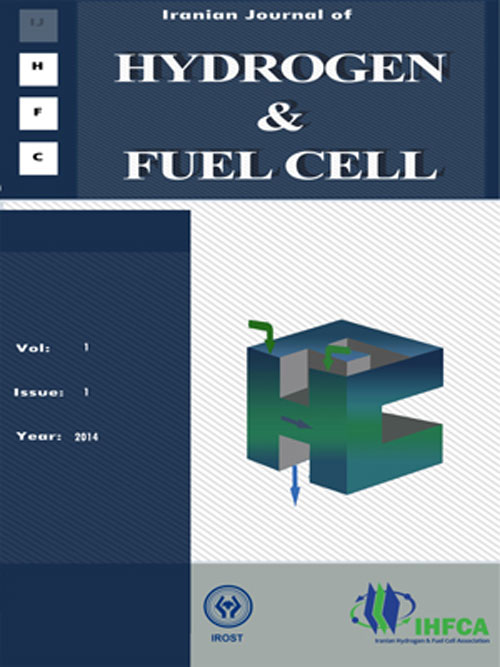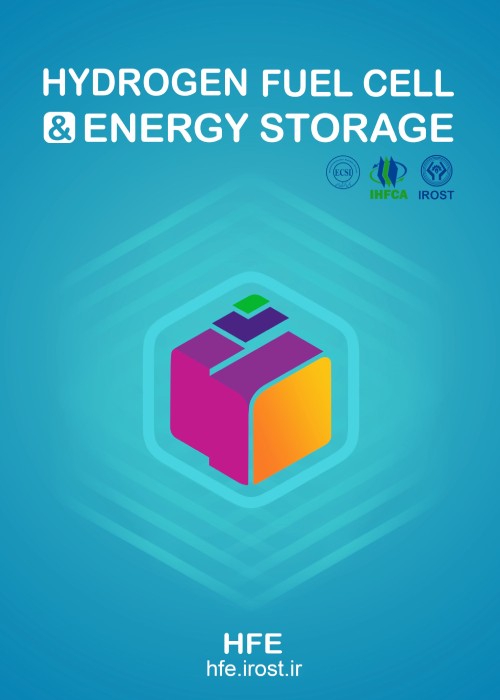فهرست مطالب

Journal of Hydrogen, Fuel Cell and Energy Storage
Volume:4 Issue: 2, Spring 2017
- تاریخ انتشار: 1396/03/11
- تعداد عناوین: 6
-
-
Pages 93-102Designing optimal microstructures for solid oxide fuel cell (SOFC) electrodes is complicated due to the multitude of electro-chemo-physical phenomena taking place simultaneously that directly affect working conditions of a SOFC electrode and its performance. In this study, a new design paradigm is presented to obtain a balance between electrochemical sites in the form of triple phase boundary (TPB) density and physical properties in the form of gas diffusivity in the microstructure of a SOFC electrode. The method builds on top of a previously developed methodology for digital realization of generic microstructures with different geometric properties in ionic or electronic conductor grains. The obtained realizations of SOFC electrode are then used to calculate TPB density and gas transport factor. In the next step, based on the obtained database, a neural network is trained to relate input geometrical parameters to those output properties. The results indicate that the TPB density is less sensitive to the geometry than the gas transport factor. Also, the smaller particles in the ionic and electronic conductor phase lead to a higher amount of TPB density. The presented methodology is also used to obtain the maximum feasible properties of microstructures and their related geometric characteristics for special target functions like maximum reaction sites and gas diffusivity in a realized model. The tradeoff between input and output parameters is another application of this modeling approach which demonstrates the TPB density and gas transport factor variation versus the geometric anisotropy of particles and porosity, respectively.Keywords: Microstructure optimization, Realization of Microstructure, Solid oxide fuel cell
-
Pages 103-118Fuel flexibility is a significant advantage of solid oxide fuel cells (SOFCs) and can be attributed to their high operating temperature. The eligibility of a combined heat and power (CHP) system has been investigated as a new power generation methode, in this study. Natural gas fueled SOFC power systems via methane steam reforming (MSR) yield electrical conversion efficiencies exceeding 50% and may become a viable alternative for distributed generation in Iran. Since the heat to power ratio of a common SOFC system is 2:1, an efficient heat recovery system has been considered to supply required heat of steam producer and recuperative heat exchangers. All the different main components in the comprehensive system were modeled and then simulated. Results showed high total energy efficiency along with minimum heat loss are feasible in the proposed cycle. Moreover, desirable methane and hydrogen conversion ratios have been attained which utilized this system for commercial power generation purposes. Eventually, cathode recycling effect on MSR combustor operation has been indicated.Keywords: Solid oxide fuel cell, Methane Steam Reforming, Energy efficiency, Heat Recovery
-
Pages 119-124Nowadays, hydrogen has attracted significant attention as a next generation clean energy source. Hydrogen is highly flammable, so detection of hydrogen gas is required. Gold nanoparticle based localized surface plasmon resonance (LSPR) is an advanced and powerful sensing technique, which is well known for its high sensitivity to surrounding refractive index change in the local environment. We put particular focus on how LSPR of gold nanoparticles can be used to sense hydrogen gas. Additionally, metal oxides are generally used as materials for high sensitivity and fast response H2 sensors. Therefore, we used both an Au and WO3 colloidal with a PdCl2 solution added as a hydrogen catalyst. In this work, colloidal WO3 nanoparticles were synthesized by an anodizing method and Au NPs were obtained by pulsed Nd:YAG laser ablation. The gold NPs showed a LSPR absorption band over the visible and near infrared region. When Au nanoparticles were added to the mixture of WO3 and PdCl2, the plasmon peak of Au nanoparticles shifted to a longer wavelength in the presence of hydrogen gas. Structural, morphological and optical properties of colloids were investigated by using a XRD, TEM and UV-Vis spectrophotometer, respectively.Keywords: hydrogen sensor, gold nanoparticles, localized surface plasmon resonance, pulsed laser ablation, colloidal tungsten oxide
-
Pages 125-138Distribution of contact pressure between the bipolar plate and gas diffusion layer considerably affect the performance of proton exchange membrane fuel cell. In this regard, an adaptive neuro-fuzzy inference system (ANFIS) is developed to predict the contact pressure distribution on the gas diffusion layer due to dimensional errors of the bipolar plate ribs in a proton exchange membrane fuel cell. Firstly, the main data set of input/output vectors for training and testing of the ANFIS is prepared based on a finite element simulation of the contact between bipolar plate and gas diffusion layer. An experimental procedure is used to validate the simulation results. Then, the ANFIS is developed and validated using the randomly selected data series for network testing. The applied ANFIS model has ten inputs made up of the dimensional errors of the bipolar plate ribs (e1 e10). The standard deviation of contact pressure distribution (Pstd) on the gas diffusion layer is the unique output of the ANFIS model. To select the best ANFIS model, the average errors of various architectures two different data series of training and testing of the main data set are calculated. Results indicated that the developed ANFIS has an acceptable performance in predicting the contact pressure distribution for the cited fuel cell model. The proposed integrated prediction model is feasible and effective for the dimensional tolerances considered. This method can reduce computing time and cost considering the acceptable accuracy of the obtaining results, and can be used to analyze the effects of dimensional errors of bipolar plate on the performance of proton exchange membrane fuel cell.Keywords: PEM fuel cell, ANFIS, bipolar plate, GDL contact pressure, dimensional error
-
Pages 139-151A modified sol-gel process has been found to significantly improve the photocatalytic activity of TiO2 nanoparticle in the process of solar hydrogen production. The surface of TiO2 nanoparticles were modified by the optimization of solvent of titanium precursor (acetic acid and/or ethanol) in the sol-gel method. A multi technique approach (SEM, XRD, FTIR, UV-DRS and TGA) was used to characterize the prepared TiO2 nanoparticles. The photocatalytic hydrogen production was tested using a suspension of photocatalyst TiO2 at 10 vol. % methanol under natural solar light. The produced hydrogen was subjected to gas chromatography with a continuous flow of N2 in the photoreactor system. It was found that the TiO2 nanoparticles synthesized with acetic acid as the solvent of titanium precursor, TiO2-AA, have a better photocatalytic activity for hydrogen production compared to nanoparticles synthesized with ethanol, TiO2-EA. The obtained results showed that the better crystallinity, small size and proper surface properties of TiO2-AA nanoparticles is due to higher photoactivity.Keywords: H2 production, Solar light, TiO2 nanoparticles, Photocatalyst
-
Pages 153-162There are several obstacles to the commercialization of PEM fuel cells. One of the reasons is that the presence of carbon monoxide (CO) in the reformatted fuel, even at a very small scale, decreases the fuel cell performance. The aim of this paper is to investigate the effect of CO in reformatted fuel on PEM fuel cell performance. For this purpose, a steady state, one-dimensional and non-isothermal model is utilized to evaluate the PEM fuel cell performance with and without CO in the fuel stream. The governing equations which includes the conservation of mass, energy and species equations are solved in MATLAB software and validated by the available data in the literatures. The results indicate that when pure hydrogen is used as anode fuel the activation loss of the cathode is very large relative to the anode value; also, the maximum temperature occurs in the cathode catalyst layer. When reformatted fuel is applied as anode gas stream, activation loss and anode temperature increase by increasing the CO concentration in the reformatted fuel. As example, when CO concentration is over 50 ppm in the fuel stream, the activation loss and anode will be higher than the relevant amounts in cathode catalyst layer. Also it is observed that by increasing the fuel cell temperature and anode pressure, the CO effects on fuel cell performance are reduced.Keywords: PEM fuel cell, CO Poisoning, kinetic effect


